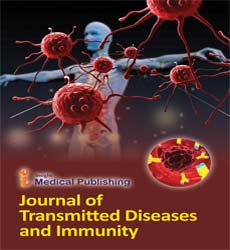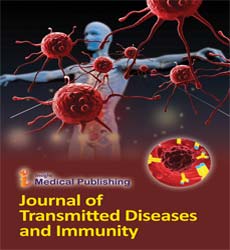ISSN : 2573-0320
Journal of Transmitted Diseases and Immunity
Roles of Immuno Proteomics in the Revelation of Autoantigens in Immune System Sicknesses
Leon Swartz*
Department of Social Development Chief Directorate, Hsrc Building Pretoria, Republic of South Africa
- *Corresponding Author:
- Leon Swartz
Department of Social Development Chief Directorate, Hsrc Building Pretoria, Republic of South Africa
E-mail: leonsar@gmail.com
Received Date: July 26, 2021; Accepted Date: July 28, 2021; Published Date: August 04, 2021
Citation: Swartz L (2021) Revelation of Autoantigens in Immune System Sicknesses. J Transm Dis Immun. Vol.5 No.4:43.
The investigation of resistant biomarkers or antigens isn't new and old style strategies like agglutination, chemical connected immunosorbent measure, or Western smudging has been utilized for a long time to examine the safe reaction to inoculation or sickness. Notwithstanding, in a large number of these customary methods, protein or peptide distinguishing proof has frequently been the bottleneck. Ongoing advances in genomics and proteomics, has prompted a significant number of the fast advances in proteomics draws near. Immunoproteomics portrays a quickly developing assortment of approaches that have the shared objective of recognizing and estimating antigenic peptides or proteins. This incorporates gel based, exhibit based, mass spectrometry, DNA based, or in silico approaches. Immunoproteomics is yielding a comprehension of infection and illness movement, immunization up-and-comers, and biomarkers. This audit gives an outline of immune proteomics and firmly related advancements that are utilized to characterize the full arrangement of antigens focused on by the resistant framework during disease. Proteomics advances are regularly utilized for the distinguishing proof of protein focuses of the invulnerable framework. Here, we talk about the immune proteomics advances utilized for the revelation of autoantigens in immune system infections where resistant framework deregulation assumes a focal part in sickness beginning and movement. These auto antigens and related autoantibodies can be utilized as possible biomarkers for sickness diagnostics, prognostics and anticipating/observing medication responsiveness (theranostics). The resistant framework normally targets unfamiliar proteins to battle contamination or forestall tumor advancement. In any case, affected by different factors like climate, way of life and hereditary pre-manner, the insusceptible framework may lose self-resilience and respond against self-proteins (autoantigens), bringing about immune system illness. The versatile insusceptible reaction against such autoantigens causes cell demise and aggravation – bringing about persistent indications normal for immune system illness. Autoantibodies and their related objective antigens have been utilized as pointers of a few immune system sicknesses. Regularly, autoantibodies are utilized as biomarkers, instead of autoantigens – primarily on the grounds that most autoantigens address proteins that exist in typical/sound individuals, while autoantibodies by and large imprint sickness subsets with autoreactivity against these self-antigens (which may/may not be transformed or post-translationally altered).
Immune system infections can either be confined to specific organs or be fundamental, with impacts in different organs of the body. Theranostic (drug responsiveness) biomarkers are accepted to be extremely helpful in foreseeing drug responsiveness and deciding time/financially savvy treatment plans. Autoantibodies are an intense wellspring of promising prognostic and theranostic biomarkers for fundamental immune system sicknesses.
Regardless of whether autoantibodies are utilized as a symptomatic, prognostic or theranostic biomarkers, they are by and large utilized in the clinical setting to test for explicit related autoantigens related with specific sickness states. This infers that if an autoantigen (and its comparing autoantibody) must be utilized as some sort of biomarker, it should be distinguished and characterized. Along these lines, it is vital to find and distinguish autoantigen focuses in explicit sicknesses, to foster powerful demonstrative instruments. Immunoproteomics incorporates a wide arrangement of proteomics advances that can be utilized for finding autoantigens/autoantibodies which may fill in as likely biomarkers.
The revelation of autoantigens/autoantibodies happens generally in three stages: (1) evaluating for explicit autoantibody/ autoantigen mixes in patients, (2) sub-atomic recognizable proof and portrayal of the autoantigen, and (3) portrayal of the competitor autoantigen's immunogenicity and the relating autoantibody marks. A typical subject in the screening stage is trying the autoreactivity of coursing antibodies inside organic liquids (such as serum, cerebrospinal liquid (CSF) or synovial fluid) from patient accomplices against proteomes sourced from essential cell culture, tissue/cell culture, tissue miniature analyzation, or misleadingly produced peptide libraries/exhibits. Proteins that test decidedly (putative autoantigens) should then be sequenced, recognized and described utilizing proteomics advances.

Open Access Journals
- Aquaculture & Veterinary Science
- Chemistry & Chemical Sciences
- Clinical Sciences
- Engineering
- General Science
- Genetics & Molecular Biology
- Health Care & Nursing
- Immunology & Microbiology
- Materials Science
- Mathematics & Physics
- Medical Sciences
- Neurology & Psychiatry
- Oncology & Cancer Science
- Pharmaceutical Sciences
